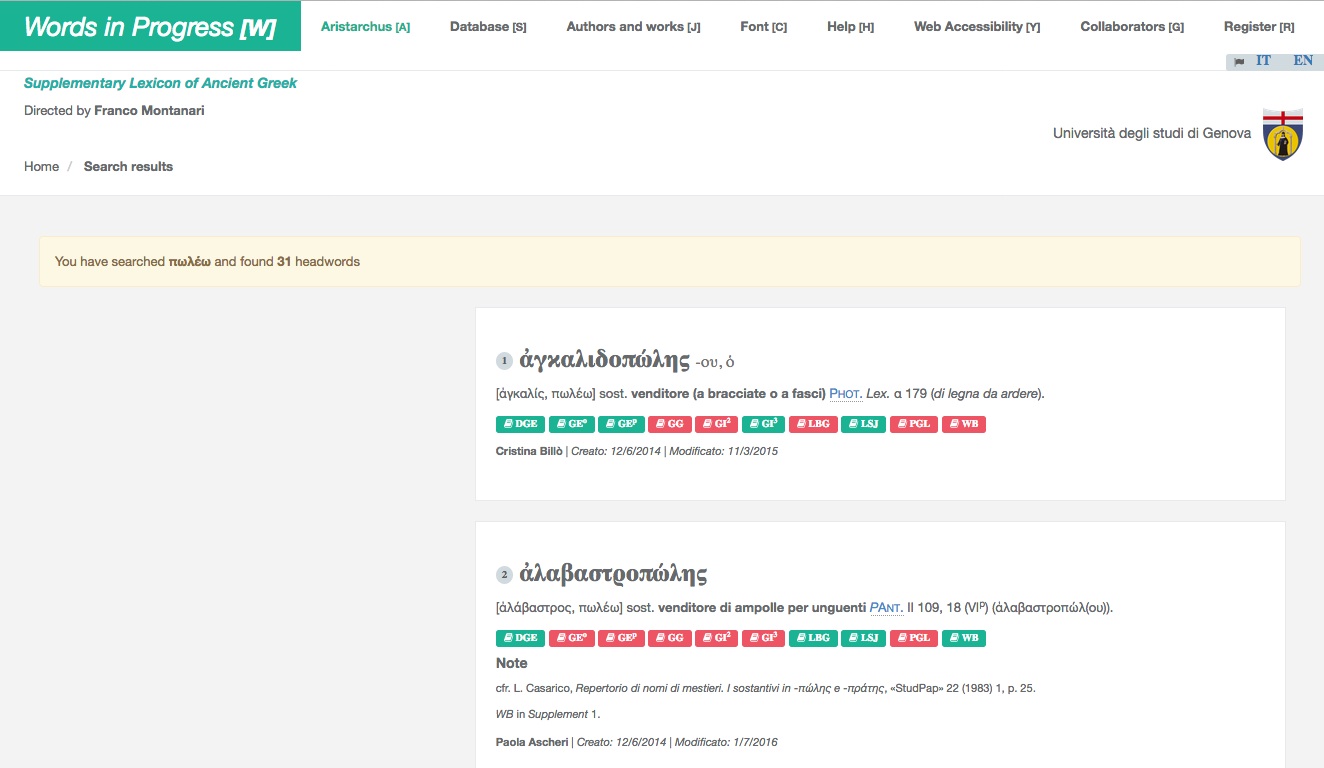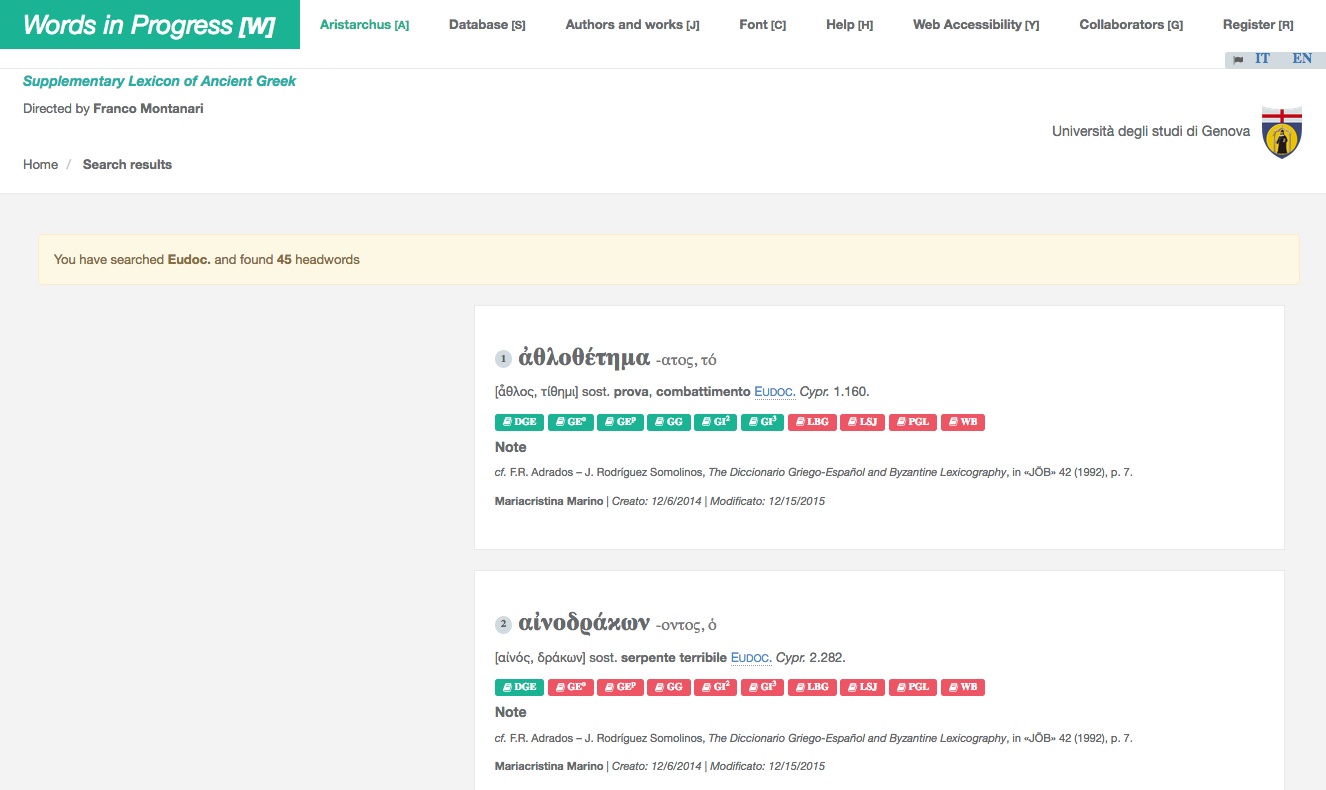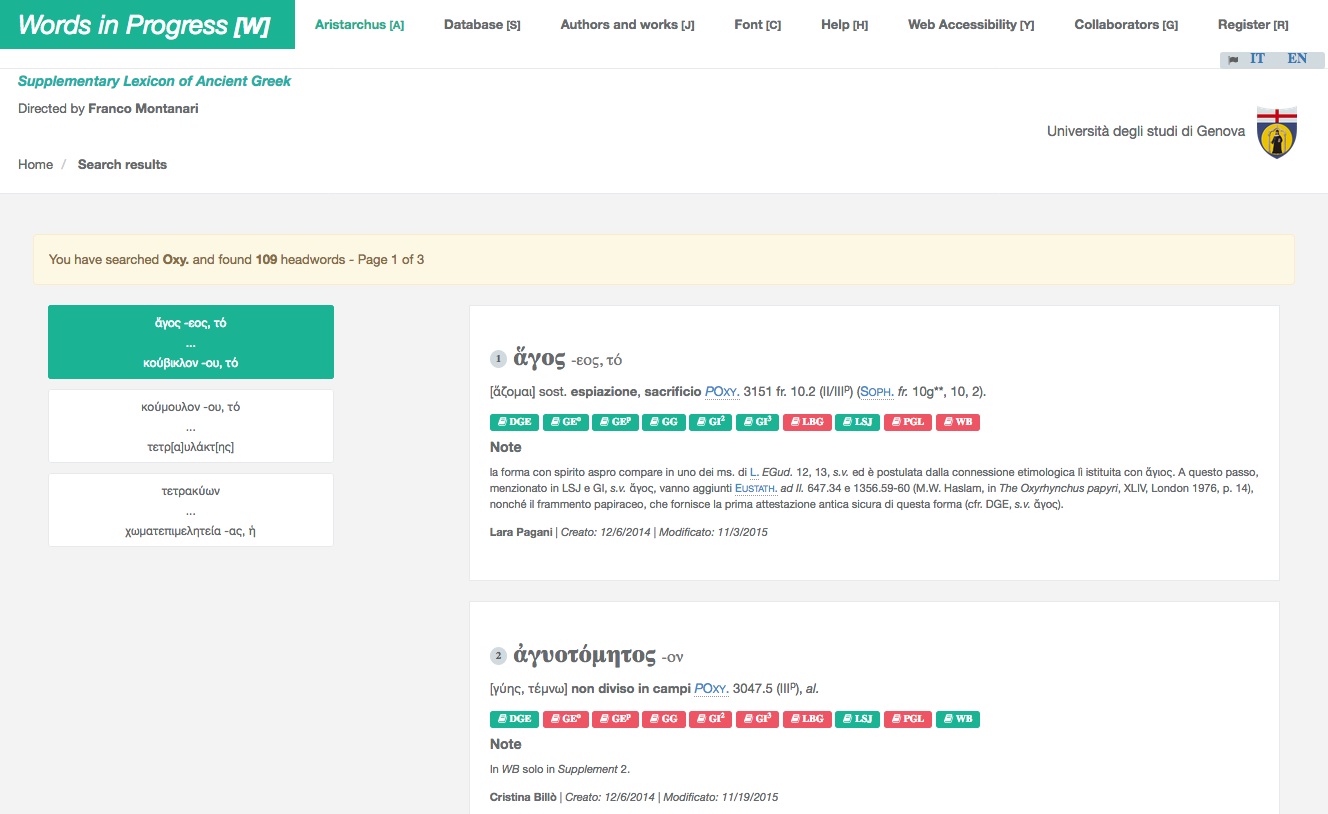Supplementary Lexicon of Ancient Greek
Directed by Franco Montanari, Serena Perrone Università degli studi di GenovaUser Guide
- headword
- etymology
- grammatical label
- translation (in the language of the entry’s author)
- sources (by clicking on the abbreviation you may see the full reference)
- possible examples
- presence/absence in the reference dictionaries *
- Notes: any other additional information or bibliographical reference
- Name of the author of the entry and dates of insertion and modification
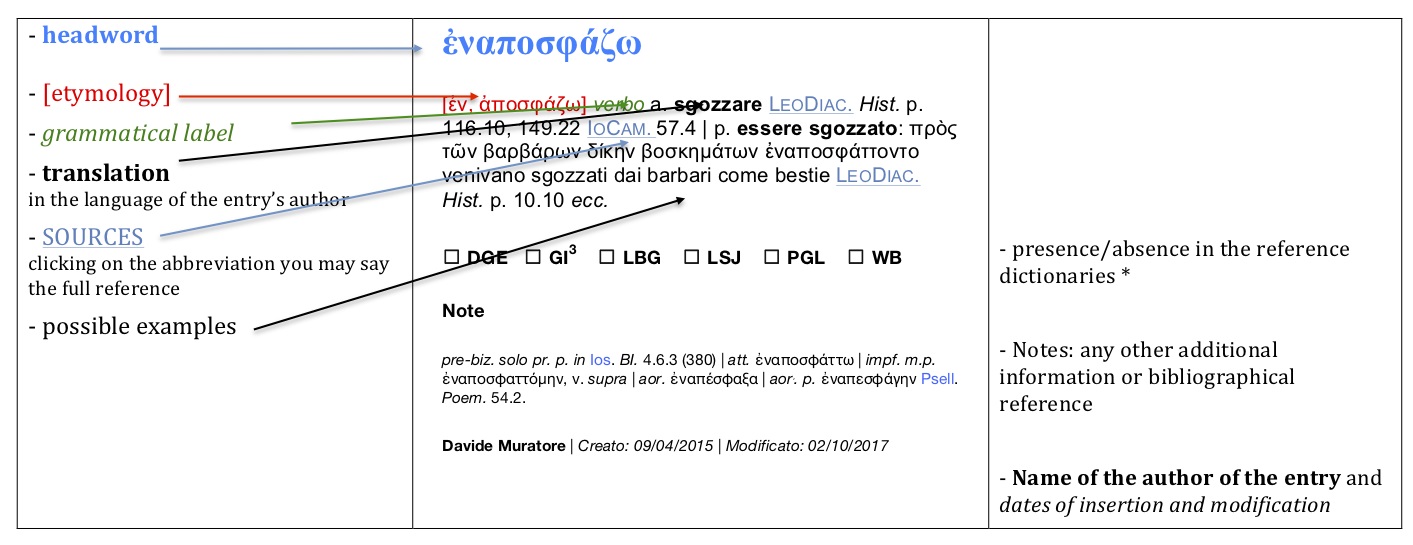
- Francisco R. Adrados, Juan Rodríguez Somolinos, DGE – Diccionario Griego-Español, online ed.
- Franco Montanari, GI – Vocabolario della lingua greca, third edition, 2013
- Erich Trapp, LBG – Lexikon zur byzantinischen Gräzität, 1994-
- Henry Liddell, Robert Scott, Henry Stuart Jones, LSJ – A Greek-English Lexicon, 1996
- Geoffrey William Hugo Lampe, PGL – A Patristic Greek Lexicon, 1961
- Friederich Preisigke, WB – Wörterbuch der griechischen Papyrusurkunden, with supplements), 1925-2000
The checkmark means that the entry is in the dictionary. Nevertheless, the WiP entry could contain more or different information, e.g. new meanings not recorded in the reference dictionaries, more ancient sources or sources reflecting a different context, and notes on problematic issues that find no room in traditional dictionaries.
By clicking on Database in the upper menu, you may either search the archive by the initial letter of the headwords or perform an advanced search.
Advanced search: You can enter either Greek or Latin strings and search for either an entire word or part of a word.
For Greek strings, type the letters on the Roman-script keyboard inside the “Greek text” textbox and the characters will be dynamically converted into Unicode glyphs, with or without diacritics. To add diacritical marks (accents and breathings) use the "Greek keyboard help" section.
Greek text searches can be either limited to the headwords (check the “In headwords” box) or full-text, so as to include etymologies, examples and all other fields (uncheck the “In headwords” box).
If you search through the "Latin text" text-area you can find all words or parts of words in Latin characters, e.g. you can search for translations of headwords. Please consider that the entries are in the language of the author who wrote them.
You can also search for new entries and new contents by using the filters “Insert date” (when the entry was inserted in the database) and “Change date” (when the entry was last modified) and by choosing a starting date or timespan.
Examples:-
Examples: “Greek” text-area: you may search for words within a specific semantic area, for example “trade”, by typing πωλέω and removing the checkmark "In headwords".
-
“Latin” text-area: you may search for a specific source, for example by typing “Eudoc.” for the author Eudocia or “Oxy.” for Oxyrhynchus papyri.
If you are a registered user, you can add your entry to the database directly from the website.
If you are not registered yet, you can sign up here (Registrati).
Then just log in (bottom-right icon) and click on “Insert a headwork” on the main menu. The editors of WiP will be glad to evaluate your suggestion for inclusion into the database. After validation your entry will be visible to all users.
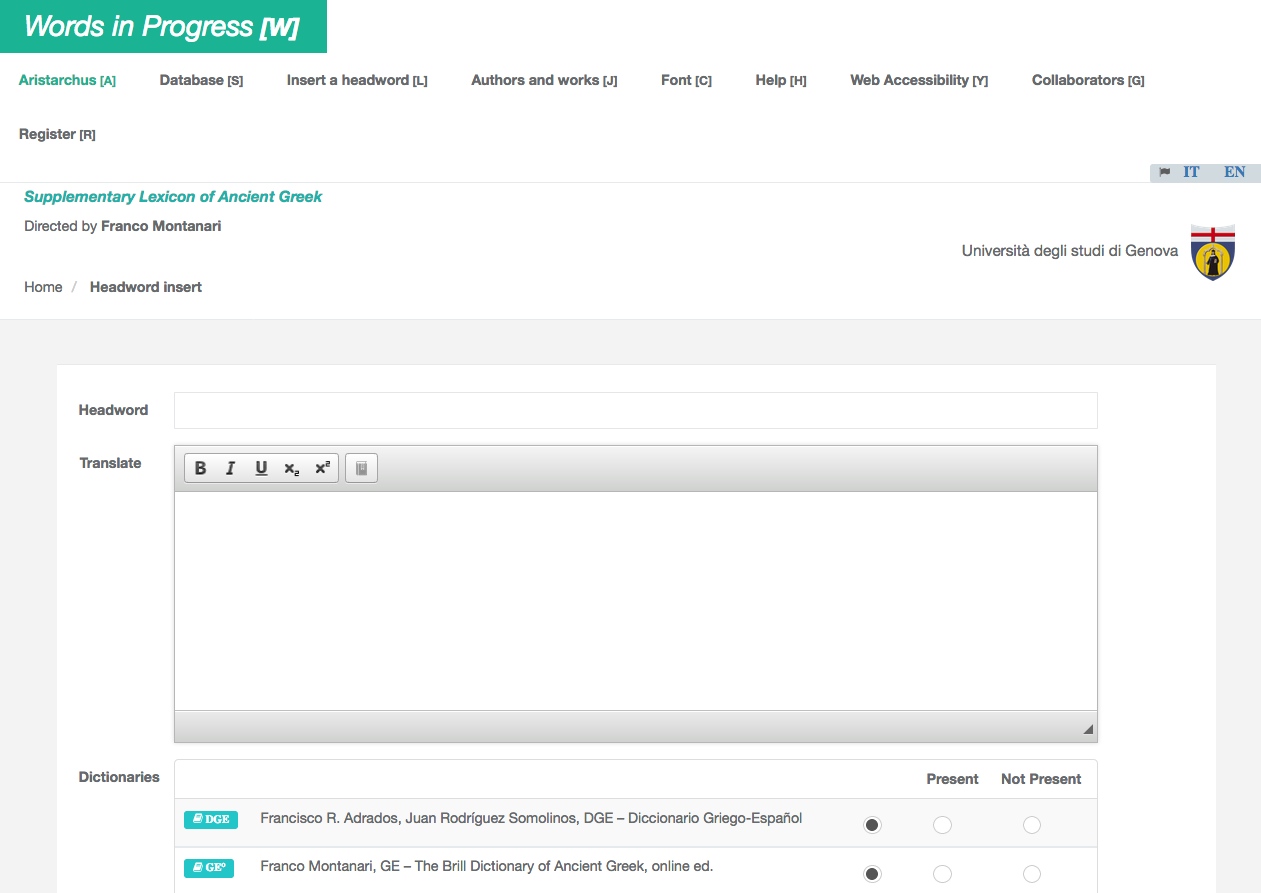
Headwords: type the headword in unicode characters.
For nouns, please also type the genitive ending and the article; for adjectives, the endings.
- the etymology enclosed in square brackets
- grammatical labels in italics (for italics just click the I button). Ex. adj., noun, adv., verb.
- the translation in bold (for bold just click the B button). Please provide a summary translation, as you would find in a traditional dictionary. Any further discussion can find room in the Notes text-area.
-
sources in chronological order. Please enter each source by using the appropriate button “Aggiungi fonte”

A window will appear allowing you to search for authors and works, editorial collections, collections of texts, papyri and ostraka, and inscriptions).
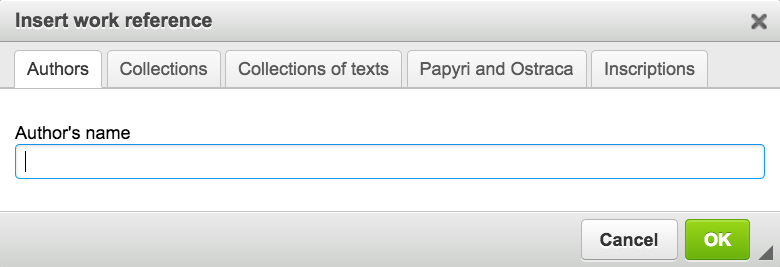 The textbox has autocomplete functionality.
The textbox has autocomplete functionality.
Once you select the author, you may also select one of his relevant works.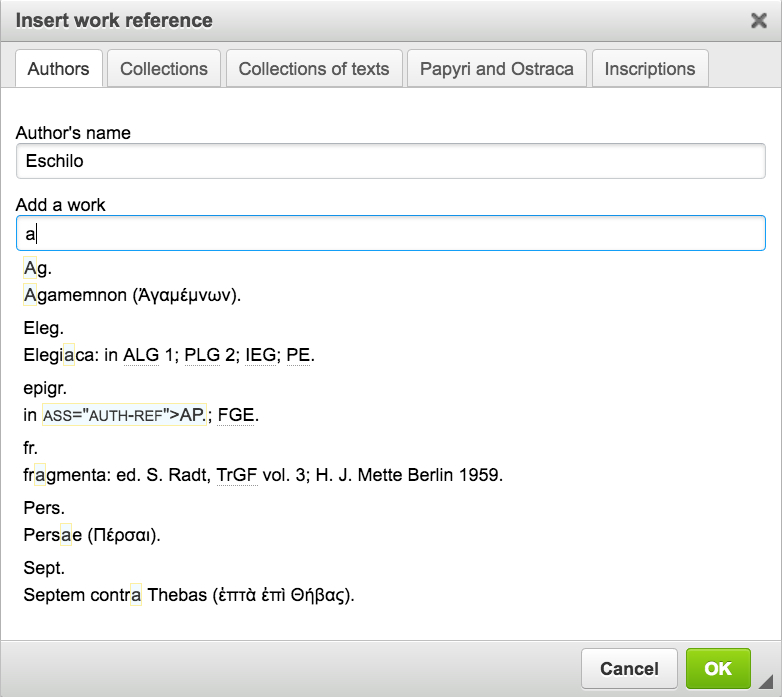
The abbreviations of authors and works are those of Franco Montanari, GI – Vocabolario della lingua greca.
A comprehensive list of the sources is available for consultation here.
If you need to cite a source that is not in the list when compiling your entry, please contact us , specifying the reference edition (a full bibliographical reference is required). - possible examples with a translation.
If the headword has more than one meaning, please use the graphic sign | to separate each meaning within the entry.
Dictionaries area: please check each reference dictionary and mark whether the headword is present or not). A headword is recorded as present in a dictionary regardless of the information provided in the entry. Thus a headword is marked as present in a reference dictionary even if the entry in that dictionary does not give the same meanings and information recorded in the WiP entry.
If you cannot check one of the reference dictionaries, just make sure not to checkmark the relevant line.
N.B. If the headword is already present in the reference dictionaries, it might be useful to specify the reasons for including it in Wip in the Notes area, for example by writing “new sources” or “meaning not yet recorded”.
Notes: this is where you can provide any further information or bibliographic references, and discuss problematic aspects.
Author: the Author is the person who has written the entry. The text-area is automatically signed with the name of the logged-in user, but you can edit it.
Once you have completed your entry, just click on “Save”. We will check your submitted entry as soon as possible.
Please consider that your entry will be visible only after validation by the WiP editorial team.
- headwords that are not recorded in the reference dictionaries;
- new meanings for headwords already present in the reference dictionaries;
- headwords based on more ancient sources or sources dealing with different subject areas compared to those already recorded in the reference dictionaries;
- any correction concerning headwords present in the reference dictionaries (including ghost words).
Should you need any further help, do not hesitate to
